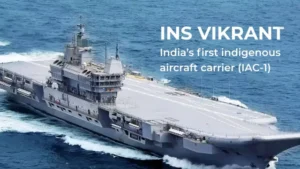India has always aimed to be a strong maritime nation. Building its own navy ships is now a big step toward that goal. The INS Vikrant stands out because it’s India’s first aircraft carrier made entirely within the country. This ship isn’t just a military asset; it’s a symbol of India’s growing tech skills and independence in defense. As a nation eager to boost its security and influence, India’s development of the Vikrant shows how it is moving forward in global naval power.
The Evolution of India’s Naval Power and the Need for Indigenous Aircraft Carriers
The Growth of India’s Naval Capabilities
India’s navy has grown a lot over the years. From early patrol ships to modern, multi-role vessels, the country’s maritime forces have expanded. The goal? Protect India’s large coastline, the Indian Ocean, and ensure regional security. Aircraft carriers play a key role here, helping project power far from home and control vital shipping routes.
Challenges with Foreign-Built Aircraft Carriers
For decades, India relied on foreign ships and technology. Some ships were bought from Russia and Europe, but that came with problems. These included high costs, maintenance issues, and limited control over upgrades. Plus, relying on other countries means India can’t easily change or advance the technology as quickly as it would like.
Strategic Motivation for the Indigenous Build
Building an aircraft carrier at home means India can control design, upgrades, and repairs. It reduces dependence on foreign countries and boosts local industries. This also helps grow India’s tech sector, creates jobs, and boosts national pride. The Vikrant is more than a ship — it’s a step toward freedom in defense manufacturing.

Development and Construction of INS Vikrant
Project Overview and Timeline
The Indian Navy began the Indian Aircraft Carrier (IAC) project more than a decade ago. The goal was to design and build a fully operational carrier domestically. The first major milestone came when the steel was cut in 2009, kicking off construction. It took about ten years, with multiple phases, before Vikrant was finally commissioned in 2022.
Design and Technical Specifications
The Vikrant measures about 262 meters long and has a displacement of around 45,000 tons. Powered by advanced gas turbines, it can operate up to 28 knots. The flight deck is designed for quick take-offs and landings, with enough space for around 30 aircraft. It carries MiG-29K fighters, helicopters, and various support systems. Modern radar and missile defenses help keep the carrier safe in modern threats.
Construction Process and Indian Naval Shipyard Involvement
Cochin Shipyard Limited was the main builder, working closely with India’s defense sector. Many local businesses and suppliers also contributed parts and technology. This collaboration was crucial for meeting project goals and boosting the domestic defense industry.
Challenges During Development
Building such a complex ship wasn’t easy. Developers faced technical hurdles, delays, and rising costs. Manufacturing a large, sophisticated vessel within India required solving many design and engineering problems. Yet, each obstacle was met with careful planning and innovation, leading to success.
Strategic and Geopolitical Significance of the INS Vikrant
Enhancing India’s Maritime Security
Vikrant strengthens India’s ability to safeguard its economic zones and strategic interests. It acts as a shield over key trade routes and supports India’s stance as a regional naval power. The carrier is designed to operate in tandem with other ships, creating a formidable fleet.
Regional Power Dynamics and Diplomacy
Launching Vikrant showcases India’s rise as a technological power. It signals to neighboring countries that India is capable of building advanced military hardware. This bolsters India’s military reputation and adds weight to its diplomatic efforts in the Indo-Pacific region.
Global Naval Trends and Comparisons
Many nations now focus on building their own ships instead of buying from abroad. Countries like China and Russia are expanding their fleets with indigenously built ships. The Vikrant fits into this global shift, highlighting India’s move toward self-reliance in military hardware.
Operational Capabilities and Future Outlook
Expected Deployment and Missions
Vikrant is equipped for a variety of roles. It will help India counter submarines, project power far from land, and perform maritime patrols. It can also be part of humanitarian missions, providing aid during disasters. Its versatility makes it a key asset for India’s navy.
Training, Crew, and Maintenance
A skilled crew is essential for operating Vikrant. India has set up training programs, often collaborating with international partners, to prepare personnel. Regular maintenance and possible upgrades will ensure Vikrant remains effective for decades.
The Path Forward: India’s Indigenous Naval Fleet Expansion
India plans to build more aircraft carriers and support ships in the future. This will help create a balanced, powerful fleet. There are also opportunities for India to develop new technologies and even export naval hardware to friendly countries.
Conclusion
The INS Vikrant marks a huge milestone for India’s defense industry. It shows that India can build world-class military equipment at home. This carrier not only boosts India’s naval strength but also sets the stage for greater regional influence. With the Vikrant, India takes a big step toward technological independence and securing its future on the seas. As India continues to grow as a naval power, its capabilities will keep getting stronger — and the world will be watching.

